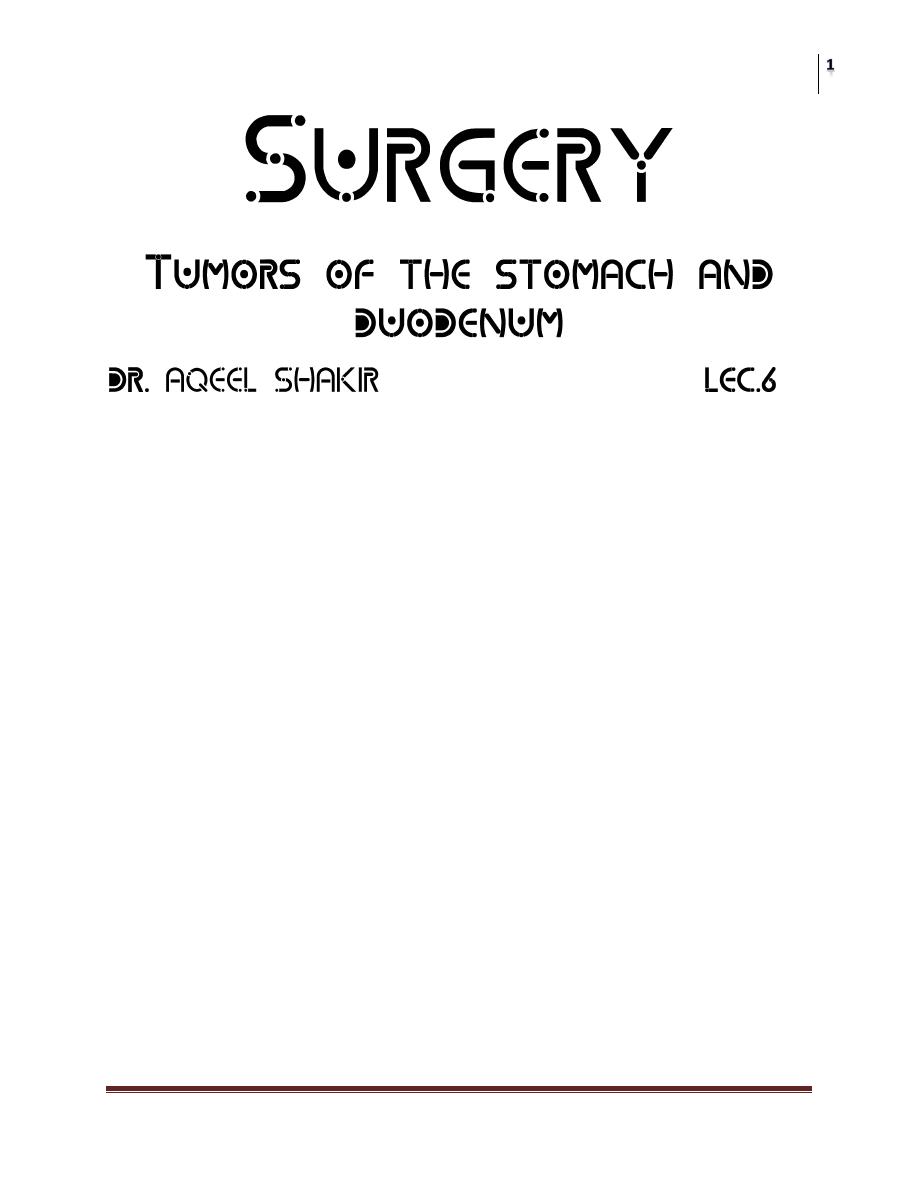
Surgery
Tumors of the stomach and duodenum
Dr. Aqeel Shakir
Lec. 6
INTRODUCTION – STOMACH
Benign:
Polyps
1. Hyperplastic
2. Fundic gland
3. Neoplastic
4. Multiple
Tumours
1. Leiomyomas
2. Lipomas
3. Heterotopic pancreas
Malignant:
Tumours
1. Carcinoma
2. Lymphoma
3. Sarcoma
4. Carcinoid
Others
Menetriers Disease
Bezoar
Volvulus

Surgery
Tumors of the stomach and duodenum
Dr. Aqeel Shakir
Lec. 6
GASTRIC POLYPS
Hyperplastic polyps
Most common type of polyp (65 – 90%)
Inflammatory or regenerative polyps
- In reaction to chronic inflammation or regenerative hyperplasia
Sessile and seldom pedunculated
- Mostly in the antrum
- Multiple in 50% of cases
- Varying in size but seldom < 2cm
Rate of malignant transformation 1 – 3%
- Usually larger than 2 cm
Fundic Gland
Small elisions in the fundus
- Hyperplasia of the normal fundic glands
Often associated with FAP
- Therefore important as a marker for disease elsewhere in the
GIT tract
Neoplastic polyps
– Types
Tubular
Villous (often larger - > 2cm - and malignant)
– Macroscopically
More often in antrum
Pedunculated with malignant potential
Solitary, large and ulcerated
– Treatment
Endoscopic removal if no malignancy identified with surveillance
Excision with malignant focus or where endoscopic removal failed

Surgery
Tumors of the stomach and duodenum
Dr. Aqeel Shakir
Lec. 6
Multiple gastric polyps
– Rare condition
Adenomatous and hyperplastic polyps
20% incidence of adenocarcinoma
– Treatment
If confined to corpus and antrum – distal gastrectomy
Otherwise total gastrectomy
– Sometimes associated with Polyposis syndromes
FAP
Gardner
Peutz-Jeghers
Cowden
Cronkhite Canada
GASTRIC LEIOMYOMA
Incidence of 16% at autopsy
Pathology
– Arise from smooth muscle of the GIT tract
Difficult to distinguish from GIST
– 75% benign
Differentiation only on mitotic index
– Large protruding with central ulcer
Usually presents with bleeding if at all
Treatment is local excision with 2 – 3cm margin
GASTRIC LIPOMA
Rare subcutaneous lesions
– Asymptomatic
– On routine endoscopy
– Require no treatment

Surgery
Tumors of the stomach and duodenum
Dr. Aqeel Shakir
Lec. 6
HETEROTOPIC PANCREAS
Ectopic pancreas
– Most common found in stomach
Within 6 cm from the pylorus
– Also in Meckl’s diverticulum
Rarely larger than 4 cm
– Sessile and rubbery
– Submucosal in location
– Histological identical to normal pancreas
ADENOCARCINOMA OF THE STOMACH
Declining incidence in western world
– due to chronic atrophic gastritis
– Also related to
Low dietary intake vegetables and fruit
High dietary intake of starches
More common in males ( 2 : 1 )
Histology
– Invariably adeno-carcinoma
– Squamous cell carcinoma from oesophagus
Involves fundus and cardia
Histological typing
– Ulcerated carcinoma (25%)
Deep penetrated ulcer with shallow edges
Usually through all layers of the stomach
– Polipoid carcinoma (25%)
Intraluminal tumors, large in size
Late metastasis
– Superficial spreading carcinomas (15%)
Confinement to mucosa and sub-mucosa
Metastasis 30% at time of diagnosis
Better prognosis stage for stage

Surgery
Tumors of the stomach and duodenum
Dr. Aqeel Shakir
Lec. 6
– Linitis plastica (10%)
Varity of SS but involves all layers of the stomach
Early spread with poor prognosis
– Advanced carcinoma (35%)
Partly within and outside the stomach
Represents advanced stage of most of the fore mentioned
carcinomas
Symptoms and signs
– Vague discomfort difficult to distinguish from dyspepsia
– Anorexia
Meat aversion
Pronounced weight loss
– At late stage
Epigastric mass
Haematemesis usually coffee ground seldom severe
– Metastasis
Vircho node in neck
Blumer shelf in rectum
Surgical resection only cure
– Late presentation makes sugary often futile
– Palliation controversial for
Haemorrhage
Gastric outlet
– Simple gastrectomy as effective as abdominal block
Splenectomy often added due to direct involvement
Only for the very distal partial gestrectomy
Rest total gastrectomy
Prognosis overall 12% 5 year survival
– 90% for stage I disease

Surgery
Tumors of the stomach and duodenum
Dr. Aqeel Shakir
Lec. 6
GASTRIC LYMPHOMA
5% of all primary gastric neoplasm's
2 different types of lymphoma
– Part of systemic lymphoma with gastric involvement (32%)
– Part of primary involvement of the GIT (MALT Tumors)
10 – 20% of all lymphomas occur in the abdomen
50% of those are gastric in nature
Risk factors
– HP due to chronic stimulation of the MALT
– In early stages of disease Rx of HP leads to regression of the disease
Primary MALT
Early stages also referred to as pseudo-lymphoma
– Indolent for long periods
– Low incidence of
Spread to lymph nodes
Involvement of bone marrow
– Therefore much better prognosis
Mostly involves the antrum
5 different types according to appearance
– Infiltrative
- Ulcerative
– Nodular
- Polypoid
– Combination
At time of presentation
– Larger than 10 cm (50%)
– More than 1 focuses (25%)
– Ulcerated (30 – 50%)
Pattern of metastasis similar to gastric carcinoma

Surgery
Tumors of the stomach and duodenum
Dr. Aqeel Shakir
Lec. 6
Signs and symptoms
– Occur late and are vague
– Relieved by anti-secretory drugs
– Diagnosis based on histology
Treatment controversial
– Surgical treatment for patients without systemic involvement
Mandatory for high grade lesions
Possible not needed for low grade lesions
Total gastrectomy and en-block for direct involvement
– Sparing duodenum and oesophagus
– Palliative resection with intra-abdominal spread
Good for bleeding, obstruction and perforations
– Radiation and chemotherapy combination for most
GASTRIC SARCOMA
1 – 3 % of gastric malignancies
Include a wide variety of tumors
– Leiomyosarcoma
– Leiomyoblastoma
– GIST
MENETRIERS DISEASE
Giant gastric folds (hypertrophic gastropathy)
Differentiate from
– Infiltrating neoplasm (Ca / lymphoma)
– CMV infection
Manifestation
– Hypo-proteinaemia due to loss from ruggae
– Chronic blood loss
Treatment
– Medical (PPI, atropine, H2 blockers)
– Surgical for refractory cases or where Ca can’t be excluded

Surgery
Tumors of the stomach and duodenum
Dr. Aqeel Shakir
Lec. 6
GASTRIC BEZOAR
Concretions in the stomach
– Tricho-bezoar (hair)
Young girls who pick and swallow their hair
– Phyto-bezoar (vegetable fibre)
Can cause erosions and bleeding
– Seldom perforate but if mortality 20%
Post-gastrectomy predisposes
– Both mechanical and chemical
Endoscopic breakage
GASTRIC VOLVULUS
2 Types
– Organo-axial
Through the organs longitudinal axis
More common and associated with hiatus hernia
Eventration of the diaphragm
– Mesenterio-axial
Line through mid-lesser to mid greater curvature
Clinical triade (Brochardt’s)
– Vomiting followed by retching and inability to vomit
– Epigastric distension
– Inability to pass NGT
Treatment
– Emergency surgery as any volvulus

Surgery
Tumors of the stomach and duodenum
Dr. Aqeel Shakir
Lec. 6
GASTRIC DIVERTICULAE
True diverticulae uncommon
– Involve all layers of the wall
– Pre-pyloric in location
Pulsion with only mucosa and sub-mucosa
– Within a few cm of GEJ
Asymptomatic found on routine investigations
– Confused with peptic ulceration
INTODUCTION – DUODENUM
Benign
Brunners gland adenoma
Leiomyoma
Carcinoid
Heterotopic gastric mucosa
Villous adenoma
Malignant
Peri-ampullar adeno CA
– Duodenum
– Cholangio
– Pancreatic head
Leiomyosarcomas
Lymphomas
Others
Duodenal diverticula

Surgery
Tumors of the stomach and duodenum
Dr. Aqeel Shakir
Lec. 6
DUODENUM Benign tumors
Brunners gland adenomas
– Small submucosal
Sessile and pedunculated variants
– Posterior wall junction D1 and D2
– Symptoms due to bleeding or onstruction
Leiomyoma
– Asymptomatic
Carcinoid
– Mostly active (gastrin, SS and serotonin)
– Simple excision
Hetrotopic gastric mucosa
– Multiple small mucosal lesions
– No clinical significance
Villous adenoma
– Intestinal bleeding
– Obstruction of ampulla with jaundice
– Risk of malignancy high (50%)
– Endoscopic snaring or local excision
DUODENUM Malignant tumors
Located in the descending part of the duodenum
Symptoms
– Pain, obstruction bleeding and jaundice
– Earlier than pancreas head
Treatment
– Pancreatico-duodenectomy for localized lesions
Much better prognosis than pancreas Ca (30% 5-year as
opposed to 0%)
– Palliative bypass procedures if not resectable
– Radiotherapy for advanced disease ?

Surgery
Tumors of the stomach and duodenum
Dr. Aqeel Shakir
Lec. 6
DUODENAL DIVERTICULAE
Incidence
– 20% at autopsy
– 5 – 10% at upper GIT investigations
Pulsion diverticulae
– 90% on the medial border of the duodenum
– Solitary and within 2.5 cm of the ampulla
– Associated gallstones and gallbladder disease
Pseudo-diverticluae
– First part of the duodenum
– Scarring of PUD
Presentation
– Chronic post-prandial pain and dyspepsia
With complicated disease
– Bleeding and perforation
– Panceatitis
– Jaundice
Surgery for complicated disease
– Dissection, removal and closure (even with perforation)
– With billiary involvement : cholidocho-duodenostomy
T
he
E
nd
